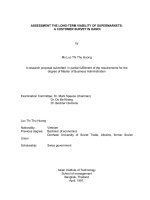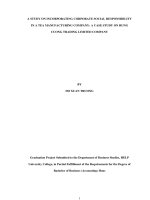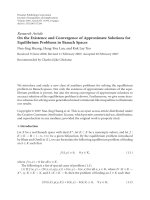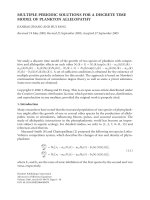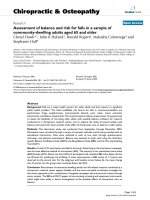The solutions for valuation in the equitization of state enterprises, the case of Vietinbank Insurance One Member limited Company
Bạn đang xem bản rút gọn của tài liệu. Xem và tải ngay bản đầy đủ của tài liệu tại đây (582.67 KB, 86 trang )
VIETNAM NATIONAL UNIVERSITY, HA NOI
SCHOOL OF BUSINESS
PHAM TRUNG THANH
THE SOLUTIONS FOR VALUATION IN THE EQUITIZATION
OF STATE ENTERPRISES, THE CASE OF VIETINBANK
INSURANCE ONE MEMBER LIMITED COMPANY
Major: Finance
Code: 60 34 05
MASTER OF BUSINESS ADMINISTRATION THESIS
Supervisor: Dr. Tran Phuong Lan
Ha noi, 2011
VIETNAM NATIONAL UNIVERSITY, HA NOI
SCHOOL OF BUSINESS
PHAM TRUNG THANH
THE SOLUTIONS FOR VALUATION IN THE EQUITIZATION
OF STATE ENTERPRISES, THE CASE OF VIETINBANK
INSURANCE ONE NUMBER LIMITED COMPANY
Major: Finance
Code: 60 34 05
MASTER OF BUSINESS ADMINISTRATION THESIS
Supervisor: Dr. Tran Phuong Lan
Ha noi, 2011
viii
TABLE OF CONTENTS
ACKNOWLEDGEMENTS
i
ABTRACT
ii
TÓM T
ẮT
v
TABLE OF CONTENTS
viii
LIST OF ABBREVIATIONS
xii
LIST OF FIGURES
xiii
LIST OF TABLES
xiii
FOREWORD
1
1. The necessity of the thesis
1
2. The purpose of the research
4
3. The objective and scope of research
4
4. The method of research
5
5. Outline of the Thesis
5
CHAPTER 1: FRAMEWORK
7
1.1 Overview
7
1.2 The methods of the valuation of the firm
10
1.2.1 The free Cash Flow to The Firm
10
1.2.1.1 Theoretical Framework
10
1.2.1.2 The FCFF model
11
1.2.1.3 The strengths and limitations of FCFF model
15
1.2.2 T
he FCFE model
1
6
1.2.2.1 Theoretical Framework
1
6
1.2.2.2 The FCFE model
17
ix
1.2.2.3 The strengths and limitations of FCFE model
1
8
1.2.3 The dividend discount model
19
1.2.3.1 Theoretical Framework
19
1.2.3.2 The dividend discount model
19
1.2.3.3 T
he advantages and disadvantages
22
1.2.4 The price multiple valuation model
24
1.2.4.1 The price to earning method
24
1.2.4.1.1 The theoretical framework
24
1.2.4.1.2 The price to earning model
2
4
1.2.4.1.3 The advantages and disadvantages
2
5
1.2.4.
2 The price to book value method
2
6
1.2.4.2.1 The theoretical framework
2
6
1.2.4.2.2 The price to book value method
27
1.2.4.2.3 The advantages and disadvantages
28
1.2.4.3 The economic value added method
29
1.2.4.3.1 The theoretical framework
29
1.2
.4.3.2 The economic value added method
29
1.2.4.3.3 The advantages and disadvantages
3
1
CHAPTER 2: EMPIRICAL STUDY ON THE NON LIFE
INSURANCE INDUSTRY AND THE VALUATION OF VIETINSCO
33
2.1 Overview of
Viet Nam insurance market
33
2.2
The influencing f
actor to valuation of the firm
36
2.2.1The Macro environment
36
2.2.1.1
Political
36
x
2.2.1.2 Economic
36
2.2.1.3 Social
37
2.2.1.4 Technology
37
2.2.2 Non life insurance Industry
37
2.2.2.1 Competition within the industry
37
2.2.2.2 Threat of new e
ntrants
38
2.2.2.3 Threat of
substitute
38
2.2.2.4 Bargaining power of customers
39
2.2.2.5 Bargaining power of
Supplier
39
2.2.3 Other factors
39
2.2.3
.1 The psychological factors
39
2.2.3
.2 The economic factors
41
2.2.3
.3 The valued factors
41
2
.3 General view about Vietinsco
42
2.3.1 General view
42
2.3.2 The structure of organization
46
2.4 The Valuation of Vietinsco
48
2.4.1 FCFF method
49
2.4.2 FCFE method
57
2.4.3 The
dividend
discount method
63
2.4.4 The price multiple valuation me
thod
65
2.4.4.1 The price to earning method
65
2.4.4.2 The price to book value method
65
2.4.4.3 The economic value add method
66
xi
CHAPTER 3: THE COMBINATION OF THE VALUATION
METHODS
71
3.1 The calculation of
the
weight rate
3.1.1 The calculation of the weight rate base on the view of author
3.1.2 The calculation of the weight rate base on the interview experts
71
71
72
3.1.3 The calculation of
the
weight rate
3.2 The valuation matrix
73
74
CHAPTER 4: THE CONCLUSION AND REC
OMMENDATION
75
Reference:
Appendix
Appendix 1 : Vietinsco historical Balance Sheet
Appendix 2: Vietinsco historical Income Statement
Appendix 3: Vietinsco Capital employed
Appendix 4: Vietinsco Ratio Forecast
Appendix 5:Vietinsco Working Capital Movement
Appendix 6: Financial Ratio
Appendix 7:Vietinsco Cash Flow Analysis
Appendix 8:Vietinsco sensitivity anaysis – Terminal Value approach –
Growth in perpetuity method of FCFF method
Appendix 9: Vietinsco sensitivity anaysis – Terminal Value approach –
Growth in perpetuity method of FCFE method
Appendix 10: Vietinsco sensitivity anaysis – Terminal Value approach –
Growth in perpetuity method of EVA method
Appendix 11: The historical data on the return of rate the stock index,
xii
treasury (a year), and Bo
nds (10 years) in US, 1928
-
2010
Appendix 12: Treasury Yield Curve Rates
Appendix 13: Estimate country Risk Premiums
Appendix 14: Interest rate per year
Appendix 15:The information market in the non life insurance field
LIST OF ABBREVIATIONS
CAPM
Capit
al asset pricing model
CEO
Chief executive officer
COGS
Cost of gross sale
D
Debt
DDM
Dividend
discount model
DIV
Dividend
value
DPS
Dividend
per share
E
Earning
EBIT
Earning before interest and taxes
EPS
Ear
ning per share
EVA
Economic valu
e added
FCF
free cash flow
FCFE
Free cash flow to equity
FCFF
Free cash flow to firm
GDP
Gross
domestic
product
NOPAT
Net operating profit after taxes
xiii
OCF
Operating cash flow/ cash flow from operating activities
P/B
Price to book
P/E
Price to E
arning
PV
Present Value
ROA
Rate of asset
ROE
Rate of Earning
Vietinbank
Viet Nam joint stock commercial Bank for industry and trade
Vietinsco
Vietinbank insurance one number limited company
WACC
Weighted average cost of capital
WC
Working ca
pital
WTO
World trade
organization
LIST OF FIGURES:
Figure 1: Growth GDP (2002-2010).
Figure 2: Non cash charges
Figure 3: The structure of organization:
LIST OF TABLES
Table 2.1: FCFF for Vietinbank Insurance Company (2010-2015)
Table 2.2: The β information market in US
Table 2.3: The input information
Table 2.4: The Valuation using terminal value
xiv
Table 2.5: The valuation using FCFF method
Table 2.6: The FCFE for Vietinbank insurance Company 2010-2015
Table 2.7: The valuation using teminal value
Table 2.8: The Valuation using FCFE method
Table 2.9: The income statement
Table 2.10: The growth rate data
Table 2.11: The valuation using DDM
Table 2.12: The economic value added valuation
Table 2.13: The valuation using terminal value
Table 2.14: The valuation using EVA method
Table 3.1: The view of experts about the weight rate
Table 3.2: The weight rates
Table 3.3: The valuation matrix
1
FOREWORD
1 – THE NECESSITY OF THE THESIS
In the context of post-crisis global economy, Viet Nam’ economy has
been growing continually to a high and stable speed. Although the pace of
global economic recovery is not all over the world, Asia has achieved quite
well. In Asia, Vietnam has continued to achieve the impressive growth.
After real GDP growth of 5.3% in 2009, Vietnam's economic growth
forecasts to 6.78% in 2010 like China, Viet Nam is not only outstanding
achievement by high growth but also a stable trend. However, comparing
with the growth of Thai Land (from -2.3 to 7.8%) and Malaysia (from -
1.7% to 7.1%) , the growth of Viet Nam is the slower than the negative
growth of countries in Asia in 2010.
Figure 1: Growth GDP (2002-2010)
Resource: International Monetary Fund, World Economic Outlook
Database, April 2011
2
However, the impressive growth performance is also accompanied
with a number of macroeconomic issues.
The first signs of risk appeared in 2007 when Viet Nam’ economy
received a surge in foreign capital inflows that have not seen immediately
after Vietnam joined the WTO. It started to the credit boom and asset price
bubbles. Since then, the problem becomes more serious with a series of
external shocks such as the world commodity price increases in 2008, the
financial crisis and global economic crisis in 2009 and the national debt in
2010 in Europe. Viet Nam now falls in unexpected high inflation rate in the
entire East Asia and Pacific (6.5%) in 2009 and approximately 10% in 2010
(International Monetary Fund, World Economic Outlook Database, April
2011).
Secondly, Viet Nam’ economy also faces to pressure on currency, to
decrease foreign exchange reserves, to be dismal stock market and balance
of high national interest rates compared to other fast growing economies in
Asian. Thus, although one of the most dynamic economies in the region,
Vietnam’ economy is also an exception from the trend of emerging market
such as more powerful currencies in general, strong capital inflows and
increasing foreign exchange reserves.
Besides, the competition between insurance companies and other
financial services such as attracting savings deposits, securities, real estate
business … is complex. The requirement of customers in service of the
insurance field is creasing, they are many the best choices and the best firm
3
for service them. So, insurance companies want to attract the customers,
they have to a detail strategy for making a strong brand name, to enhance a
service quality by performing the commitment to the method, manner and
compensation duration, to bring more value added service for customers
instead of lowering premiums and promotion before. More over, not only
the number of foreign insurance companies licensed to operate in Viet Nam
but also the number of domestic insurance companies are increasing, they
have a strategy to dominate the market, increasing the market share in
various forms including marketing and advertised techniques to accept
losses for a long time ( even over 5 years ), the result of this strategy creates
the unequal competition with other insurance companies but this operation
is suitable to the insurance business law. The policy of insurance business
management is more complete and more close to both promote self reliance
of insurance company and ensure the legitimate rights and interest of the
clear and better insured.
The equalization of state enterprises is considered an effective tool to
enhance competitiveness, to improve the management capacity and
management administration, to improve the efficiency of property
management and the development of various kinds of products and services,
what supply the needs of increasingly complex and diverse customers.
The equalization of state owned enterprises is also committed to
participate in Viet Nam's integration into the international economy
.However, the equalization of state enterprises should comply with the
requirements strategy, coordinating between the State's policy with
4
Vietnam's commitments and the basic characteristics of the economy of
Vietnam. Therefore, the equalization of state owned enterprises such as
Vietinsco if to be done right, Vietinsco will enhance completely in domestic
and foreign markets as well as to meet the management requirements of the
particular business, to contribute to raise the efficiency of Vietinsco in
particular and to promote growth and economic development in general
Moreover, Vietinsco is a component of the Vietinbank, the
equitization of state owned enterprises is part of a roadmap for equitization
of Vietinbank.
2- THE PURPOSE OF THE RESEARCH
Theoretical methods of valuation of enterprises in the equitization of
state enterprises resolve the need of business valuation.
The purpose of the research is to analyze and to evaluate the business
activities of Vietinsco.
On the basis of theoretical research on business valuation in the
equitization of state enterprises and Vietinsco of valuation process, the
thesis proposes the value of Vietinsco what it is suitable with price market
and the provision of law.
3- THE OBJECTIVE AND SCOPE OF RESEARCH
The objective of research is Vietinsco and the business of Vietinsco
from 2008 to present.
The scope of research is comprehensive Vietinsco, regardless of
5
branch’ Vietinsco. Therefore, the financial statements of Vietinsco will be
the range of focused research topics
4- THE METHOD OF RESEARCH:
To achieve the research objectives, author mainly use to the methods
in the thesis such as analysis, synthesis, comparison, qualitative method,
quantitative method, and technical method in related research topics of the
thesis
5- OUTLINE OF THE THESIS:
In order to provide an overview of the structure of the thesis, author
briefly introduces each chapter as following.
Preface:
It provides the background that familiarizes the reader to the subject.
The thesis’ research problem is formulated and defined, and followed by
purpose. Author introduced general information about the economy, the
industry and market of insurance.
Chapter 1: Framework:
This chapter will present a theoretical review on the fundamental firm
valuation models as well as frameworks that has been chosen as a base for
the empirical study.
6
Chapter 2: Empirical study on non life insurance industry and the
valuation of Vietinbank insurance company
Author presented the non life insurance market in this chapter. The
second part of this chapter is to analyze and calculate the value of the
vietinbank insurance company base on the theoretical framework of chapter
1.
Chapter 3: The combination of valuation methods
Using the view of author and experts, we know about the weight rate
to determinate the value of the Vietinbank insurance company.
Chapter 4: Conclusion and recommendation
7
CHAPTER 1: FRAMEWORK
1.1 OVERVIEW
The determined valuation of the firm is a process of determined
monetary value for the firm that this value can be accepted by buyers or
investors. The firm is determined the valuation when the firm is operating
and to be interested by investors.
The determined valuation of the firm is an important stage in the
process of the innovation firm, restructuring the economy, and also often
using by the restructured organization, the restructured line production or a
part of business of the firm.
Some issues to be pay attention in the determined valuation of the
firm.
- The price of the firm is determined at a specific time: with the firm,
its value is only determined when there is a need for certain transaction
such as trade, separation, merger, joint venture … In other word, the value
of the firm is determined to supply the specified purposes. Because the
character of the firm is a operating organism, its material is always
incessantly active. Thus, the value of the firm is determined by the certain
methods, it bases on the information, data, documents at a specific time,
specially it must be considered analysis in the context of the market at this
time. When the conditions of data, of market change, the value of the firm
is also change. So the determined valuation of the firm is always linked to
8
a specific time, if a certain conditions of market change, the value of the
firm will not be used amid it must be redetermined.
- The value of the firm depends on the future results of this estimated
firm:
As the mention above, the buyers pays the sellers the price of the firm,
the purpose of the buyers is earn money from the future operation of the
firm. The valuation of the firm depends on two factors: future expected earn
and expected rate of the capital of investors.
The first factor is future income to be determined from future
estimated results of the operating business. The higher results of operating
business in the future is estimated by the investors , the valuation of the firm
is higher, and on the contrary, the valuation of firm is lower.
The second factor is the ratio of the capital of expected investors.
This is the opportunity cost of capital that the investors estimate to base on
the ratio of the capital achieved to the minimum capital with the level of
risk.
- The value of assets is determined on the basis of its future profits:
According to principle account, book value is historical cost, any
goods and assets of firm are accounted on the books that it reflects the
purchased price. The market prices exclude the inflation. Therefore, in the
case of inflation, the book value will not reflect the intrinsic value of assets,
goods what the firm is using and managing them.
9
Unlike the principle account, the valuation of the firm is the process
of determined value of the firm. The firm is an operating organism, all
assets of the firm are used to do the business and to joint the process of
making profit of the firm. Therefore the value of an asset is determined on
basis of its future profits. The asset will be higher value when it can create
to more profits in the future and vice verse.
- The net asset value affects the value of the firm;
In the firm, all assets are managed and used to aim the highest
economic efficiency of the firm. However, it is not all assets of the firm that
the firm manages, are owned by the firm. The asset of the firm (the net asset
value of the firm) is the value of the assets of the firm except debt payable.
Thus, when the value of the firm is determined, we not only consider the
managed assets of the firm, but also look the resource of capital assets. The
value of the firm is only suitable when the assets of the firm are eliminated
debts.
- The relationship of supply and demand affect the market value of
the firm:
The market value of an asset is a sale price of this asset. This price is
a common price in the determined market condition. In fact, the information
about the asset and the price of this asset is often not available, so the value
of an asset is the price of this asset that almost buyers will pay.
10
But in fact, investors often use the various methods to make the value
of the firm. Specially, each investor has research, valuation, market analysis
of his individual, so many investors also use the same method of valuation
of the firm but the result of valuation is different. The difference of the
result has the reason of investors’ different information input and risk
perception.
For the firm, the last value of this firm depends on the market
demand, so the firm has many interested buyers in the market, the value of
this firm will much higher than the real value of it.
1.2 THE METHODS OF THE VALUATION OF THE FIRM:
At the moment, there are many methods to evaluate the value of the
firm in the world. However, in the scope of this thesis, the author will focus
the main methods such as the free cash flow to firm, the free cash flow to
equity, the Dividend discount model, the price to earning, the price to book
value, the economic value added.
1.2.1 THE FREE CASH FLOW TO FIRM:
1.2.1.1 THEORETICAL FRAMEWORK:
Based on the principle, the value of the asset must be equal to what it
will receive from this asset in the future. That mean we must estimate how
much the cash flow to generate from this asset in the future. Because the
11
firm is always expected to operate forever, or at least it is not easy for us to
estimate the time of the close firm, this cash flow is estimated forever.
This method of valuation of the firm, including debt and equity, is
used to estimate the cash flow after eliminated the operating cost and taxes
but excluding loan. In order to determine the price of capital share, the
value of the firm is continuously eliminated debt value. This is the general,
highly scientific method.
1.2.1.2 THE FCFF MODEL:
Present value of FCFF of the general model:
Firm value = FCFF discounted at the WACC.
Firm value = Σ [FCFFt / (1 + WACC)t)]
Σ: t = 1 to infinite.
Equity value = firm value - debt value.
Equity value = Firm value - MVd
MVd: the market value of debt.
Dividing the total value of equity by the number of outstanding
shares gives the value per share.
WACC can be either based on the current market weights of equity
and debt or target weights. In case of market weights-based WACC, the
formula is
12
WACC = MVd / [MVd + MVe] x rd (1 - T) + MVe / [MVd + MVe] x re
Where
MVd is the market value of debt.
MVe is the market value of equity.
rd is the pre-tax cost of debt.
re is the cost of equity.
T is the tax rate.
The cost of debt can be obtained directly from the market as the yield
to maturity on the company's debt or comparable companies' debt. To
calculate the cost of equity we can use methods such as CAPM, Arbitrage
pricing theory or cost of debt plus risk premium.
If FCFF is growing at a constant rate g, the value of the firm is:
Firm value = FCFF1/(WACC - g) = FCFF0(1 + g) / (WACC - g)
Computing FCFF from net income:
FCFF = NI + NCC + Int (1 - Tax rate) - FCInv – WCInv
Where:
NI: Net income available to common shareholders. It is the
company's earnings after interest, taxes and preferred dividends.
13
NCC: Net non cash charges. They represent depreciation and other
non-cash charges minus non-cash gains. The add-back of net non-
cash expenses is usually positive, because depreciation is a major part
of total expenses for most companies.
Int (1 - Tax rate): After-tax interest expense.
We add this back to net income because
o FCFF is the cash flow available for distribution among all
suppliers of capital, including the debt-holders, and
o Interest expense net of the related tax savings was deducted in
arriving at net income.
The add-back is after-tax, because the discount rate in FCFF model
(WACC) is also calculated on the after-tax basis.
FCInv: Investment in fixed capital. It equals to capital expenditures
for Property, Plant & Equipment minus sales of fixed assets.
WCInv: Investment in working capital. It equals to the increase in
short-term operating assets net of operating liabilities.
Note that working capital for cash flow and valuation purposes is
defined to exclude cash and short-term debt (which includes notes payable
and the current portion of long-term debt).
o Cash and cash equivalents are not taken into consideration,
because it is the change in this account that is explained by FCFF.
14
o Notes payable and the current portion of long-term debt are also
ignored, because these accounts pertain to financing decisions,
and FCFF describes operating and investing activities only.
Note: Non cash charges
If an analyst wants to use an add-back method, the analyst must be
careful to add back only non-cash component of such charges. As one
example, restructuring charges can involve cash expenditures and non cash
charges. For example, severance expense, which is incurred in the same
year, should not be added back to net income, because it is a cash charge.
On the other hand, a write-down in the value of assets as part of a
restructuring charge is a non cash item.
Sometimes non-cash items should be subtracted from, instead of
being added back to, net income. Examples are non-cash gains on sale of
assets, or reversal of previous restructuring charges.
Particular diligence should be exercised in determining effect of
deferred taxes and tax benefits of employee stock plans on FCFF. Deferred
taxes generate cash flows only if they are expected to reverse in the future,
otherwise they should be added back to net income in calculation of FCFF.
Conversely, employee stock ownership plans generate cash flows
only if they are not reversed in the future. Consequently, benefits associated
with employee options should be subtracted from net income for the
purpose of FCFF forecasting, if their reversal is expected in the near future.
15
We summarize the common non cash charges that impact net income
and indicate for each item whether to add it or subtract it from net income in
arriving at FCFF:
Figure 2: Non cash charges
1.2.1.3 THE STRENGTHS AND LIMITATIONS OF FCFF MODEL:
The advantages:
Wide applicability for different dividend and financing policies.
In contrast to dividends, a record of free cash flows is observable for
any company.
Since FCF model is based on the capital exceeding operational needs,
it is useful for valuation of control ownership that allows investors to
redeploy this capital.
16
The disadvantages:
If FCF < 0 due to capital demands.
Many companies have negative free cash flow for years due to large
capital demands. Since prediction of free cash flow far in the future
would be imprecise, FCF model cannot be used for growth
companies.
The new firm or the shortly operational firm: it is not enough
historical data to estimate the future data.
The firm is operated by the cycle of business: it is easy to estimate
wrongly the data that it is calculated in the peak position or the
bottom of recession.
The firm, which has useless assets or invented assets, has the
incorrect estimation by forgetting the profitability of these assets.
The restructured firm or the firm relating the merge and acquisition:
the measured influence of the restructure, the synergy is very difficult
but they are main influences to relate the most value of the firm.
Besides, this method is required the level of finance. The calculation
of the cash flow in the future is still asked the information of the firm,
the industry, the macro economy. Thus, it is more suitable to the firm
than to the private
1.2.2 THE FREE CASH FLOW TO EQUITY MODEL:
1.2.2.1 THE THEORETICAL FRAMEWORK:
